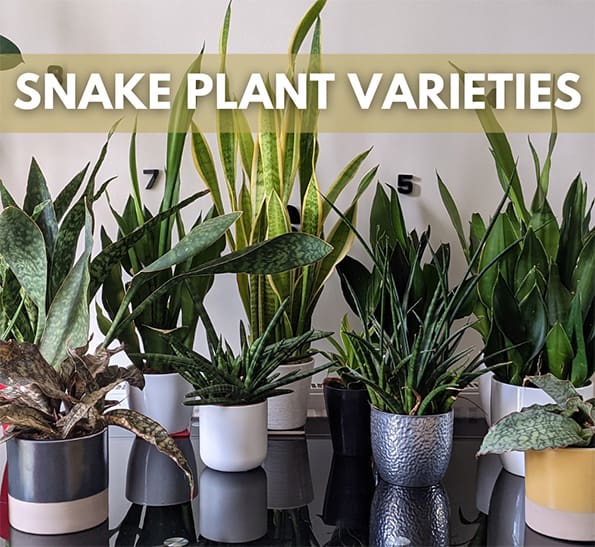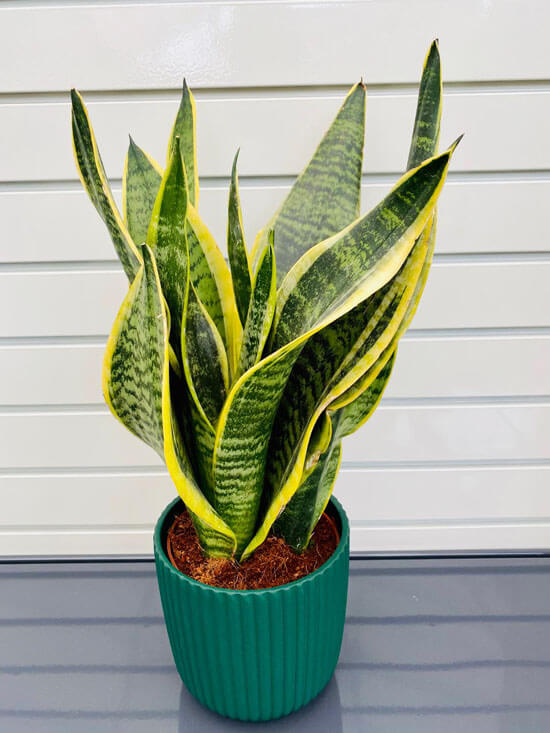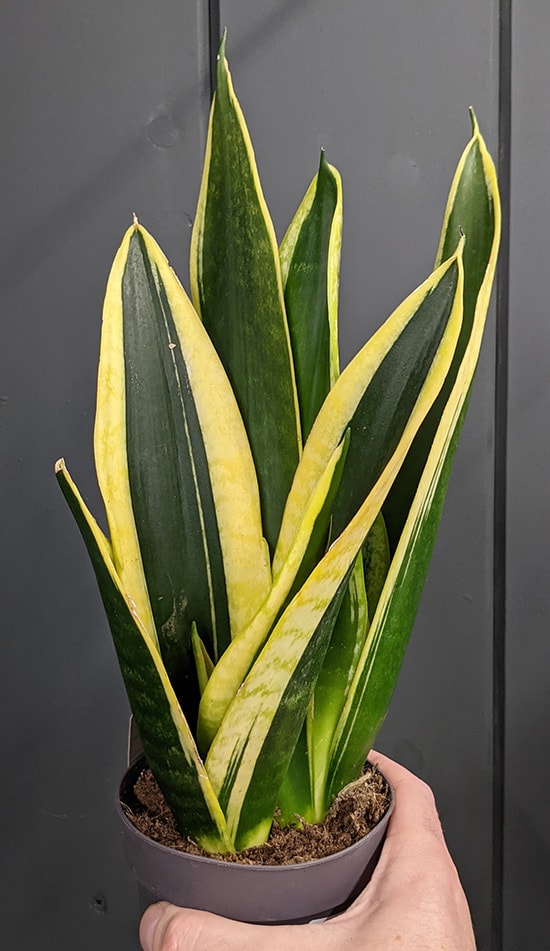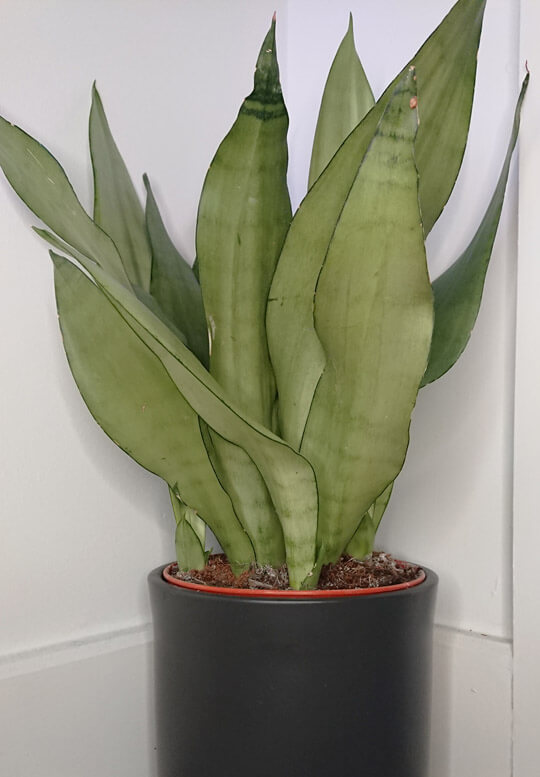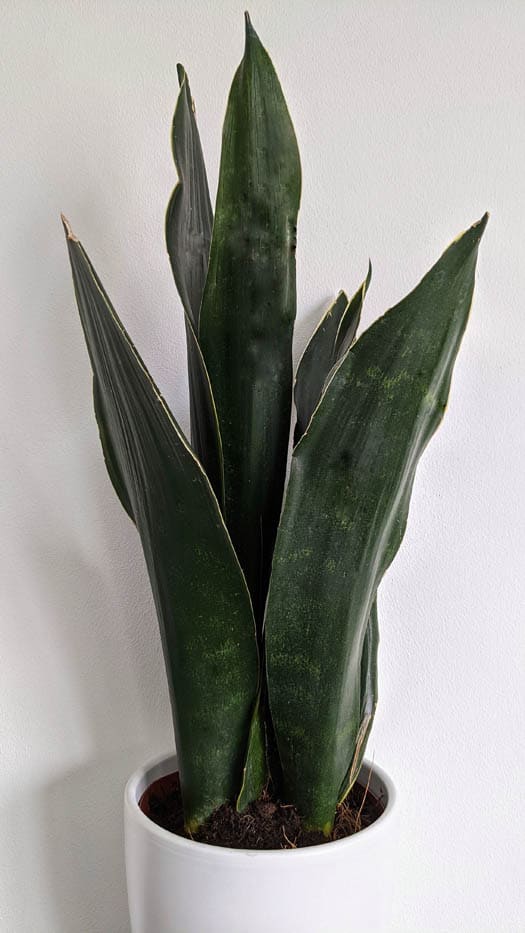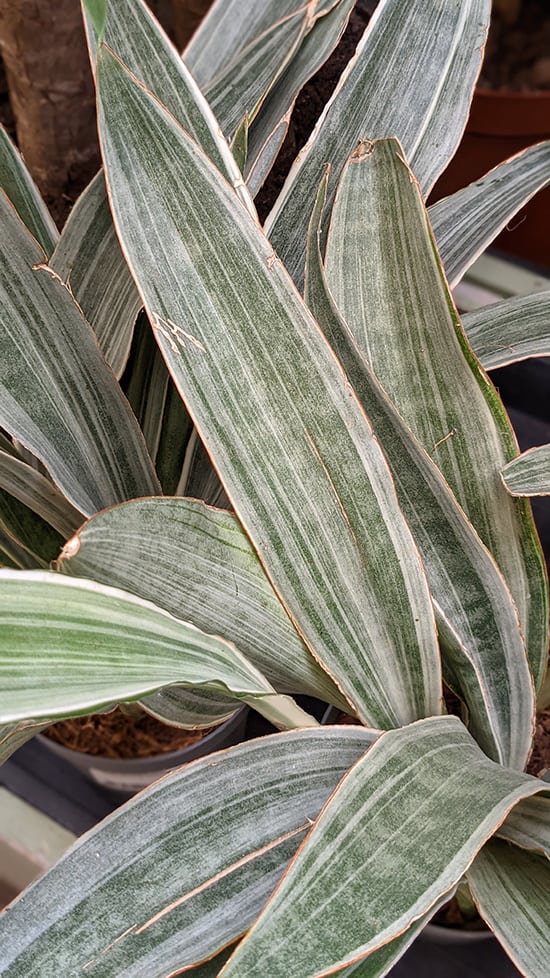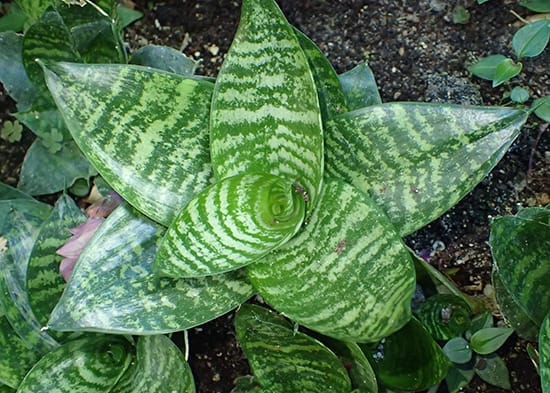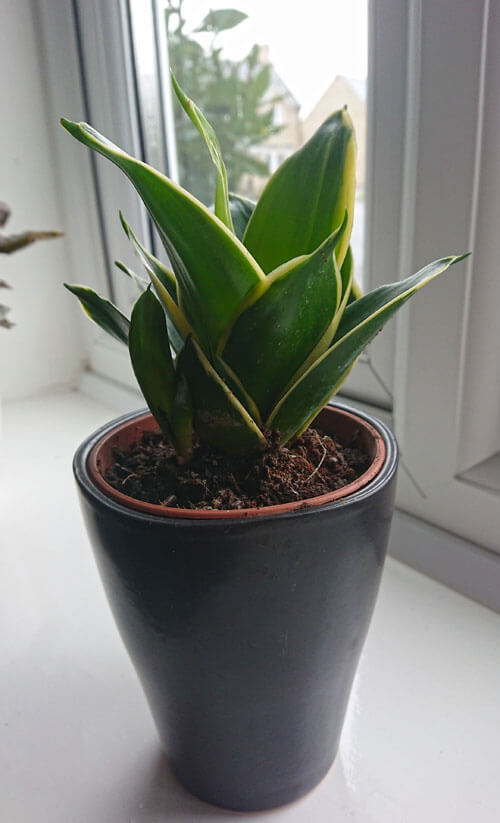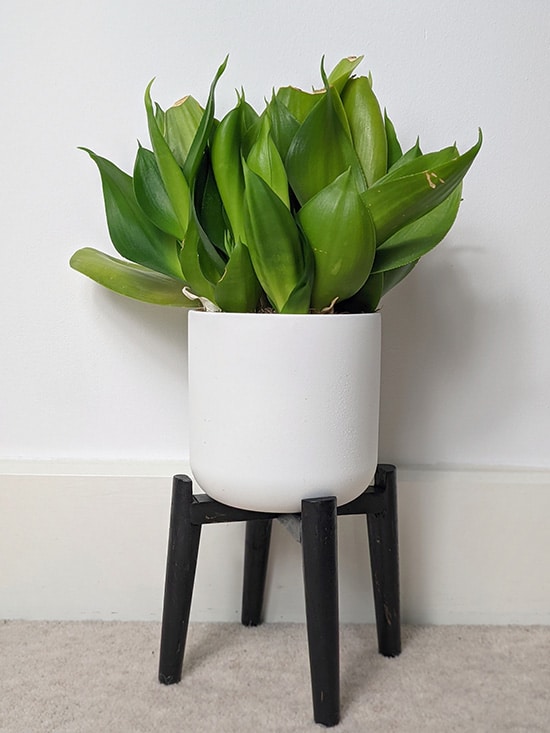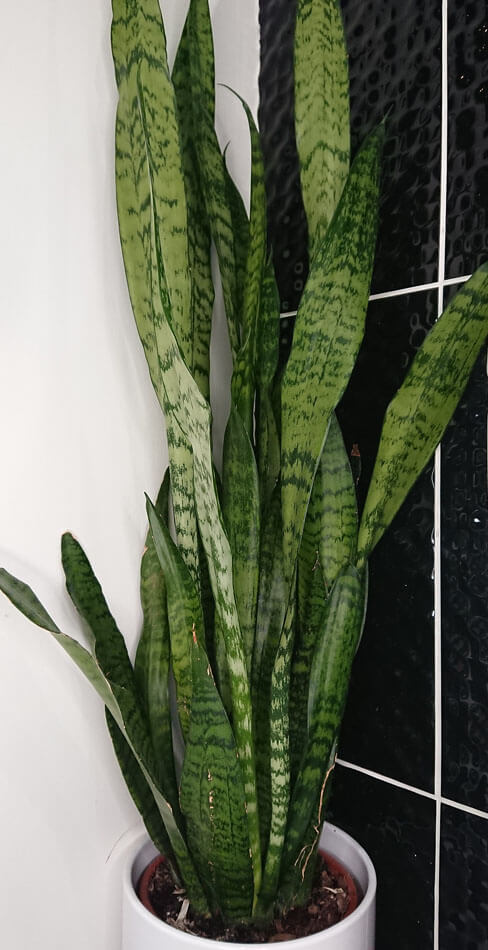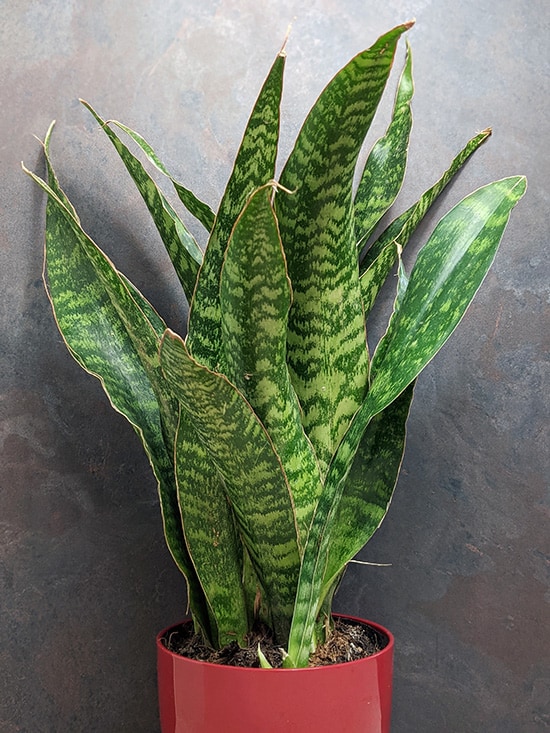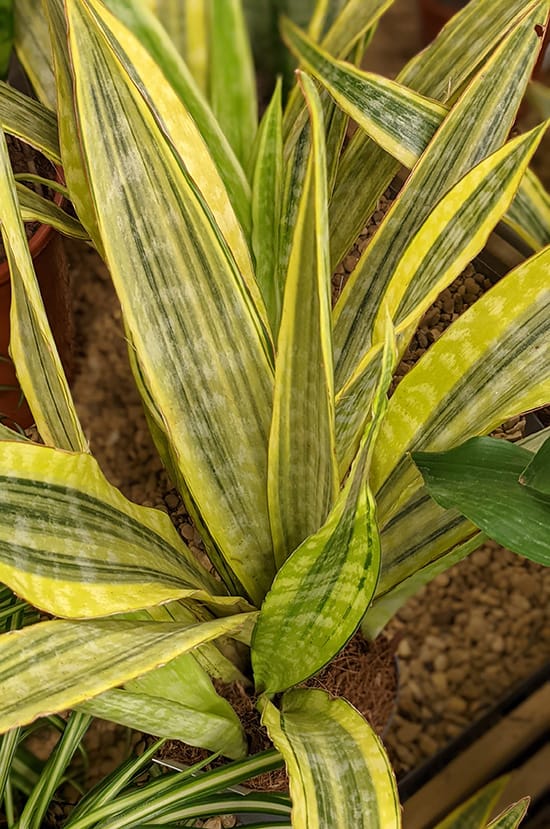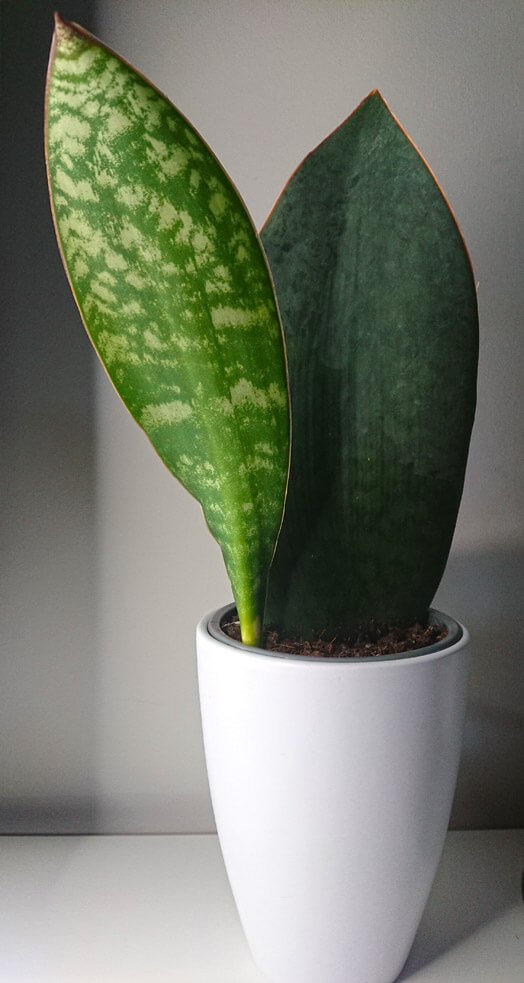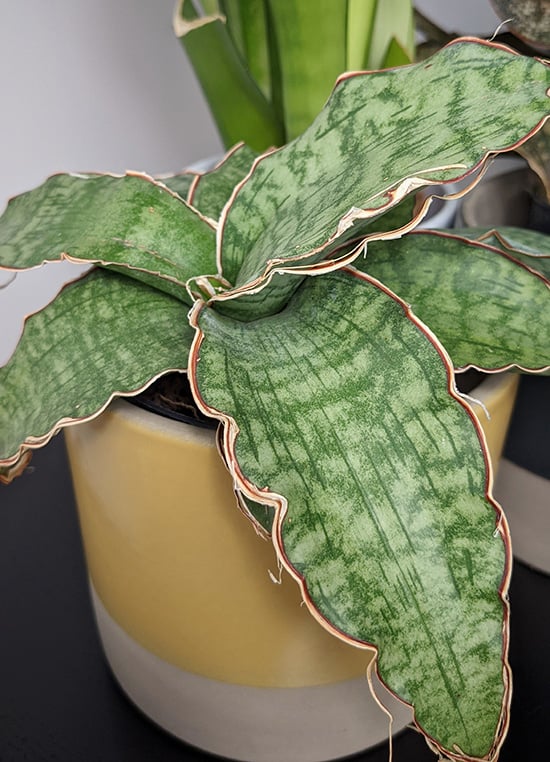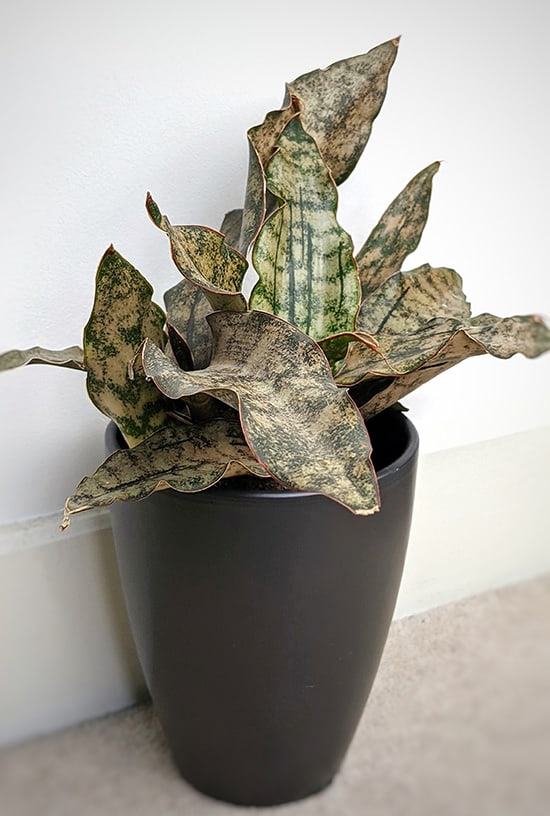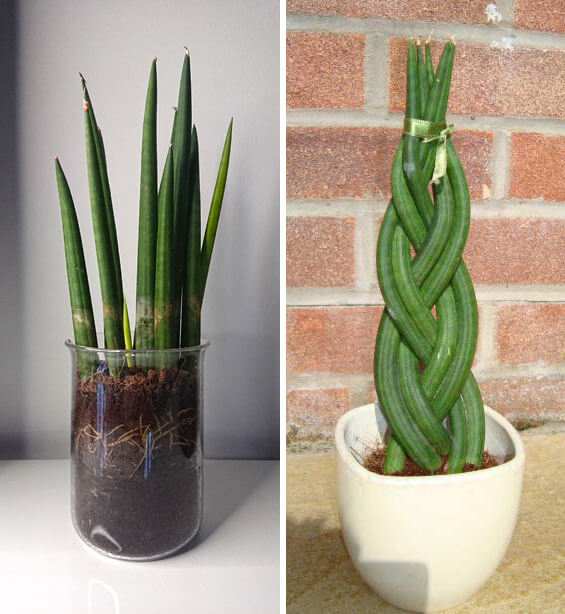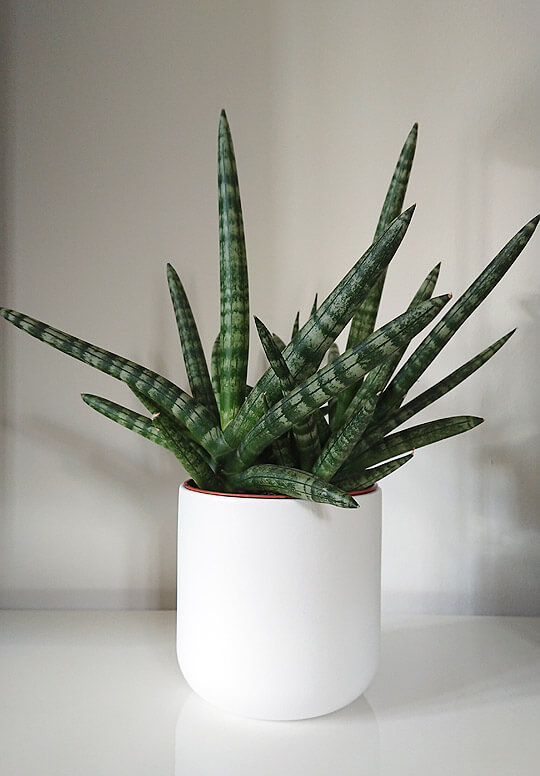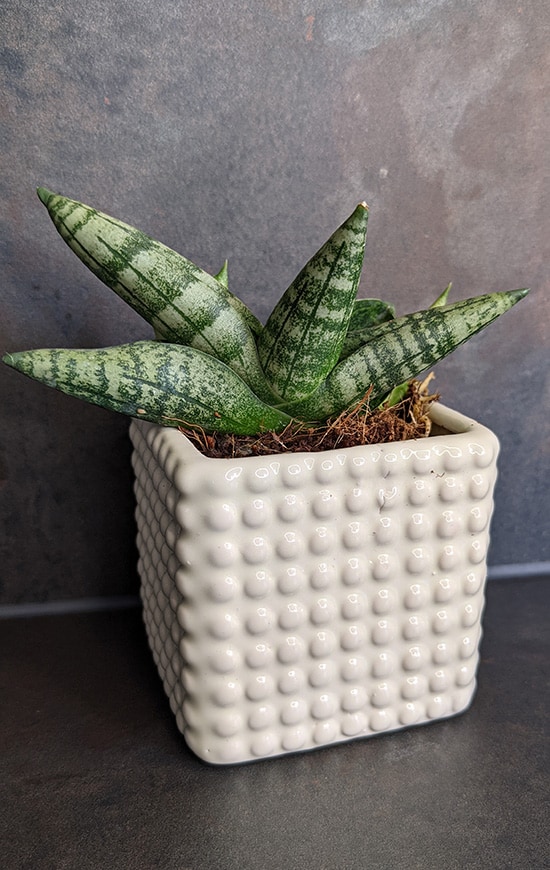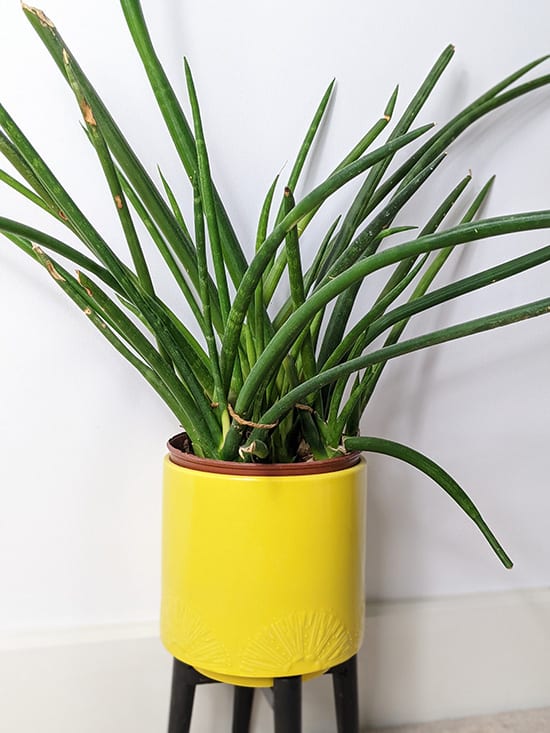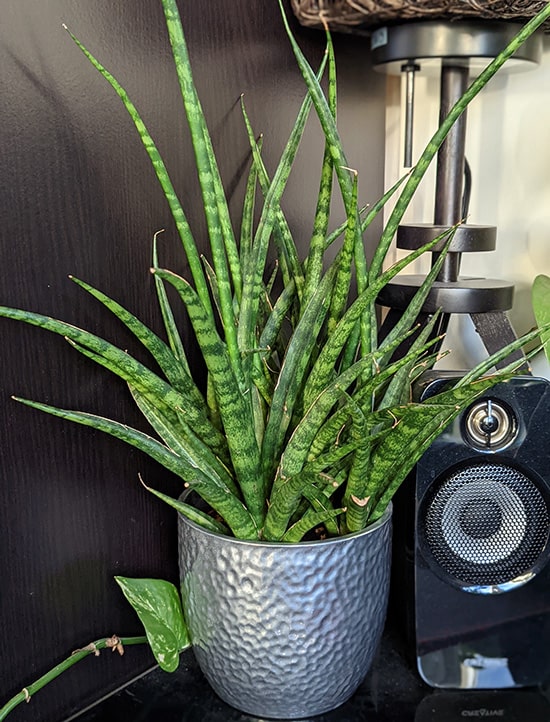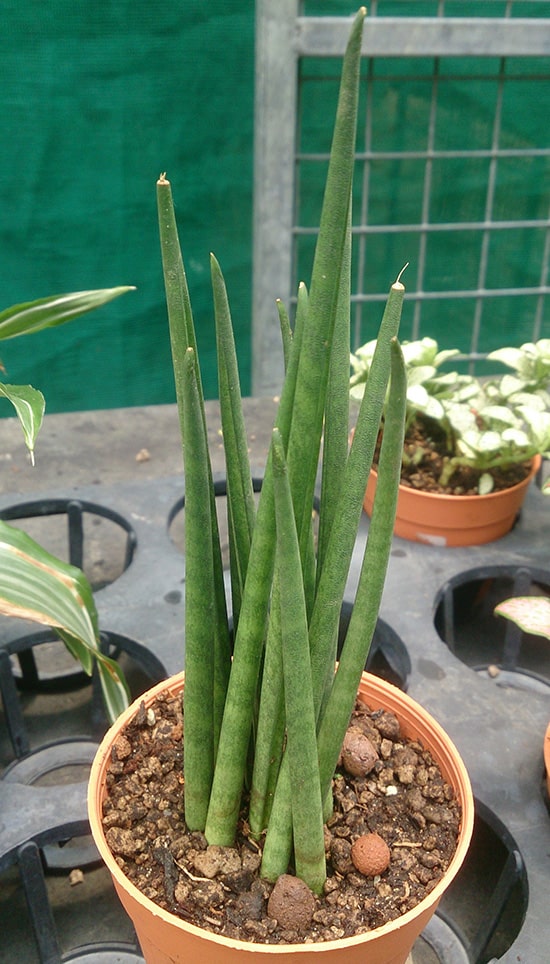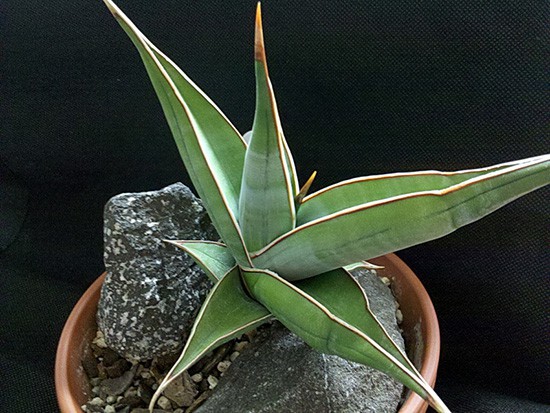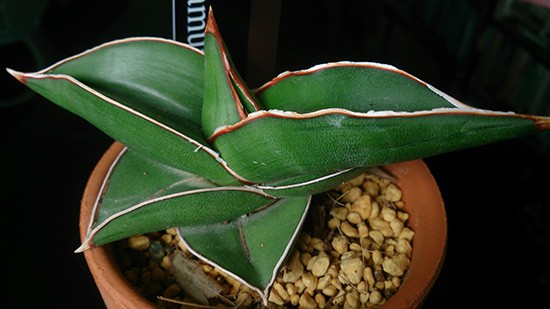Sansevieria trifasciata, or the Mother-in-law’s Tongue, is the most popular and recognised Snake Plant. But there are a large number of different Sansevieria varieties out there that you may be able to get your hands on.
Over 70 (and counting) different types are available to bring into your home, and this article looks at some of the favorites. Some are popular and more commonly found, but I've added a few curveballs that are harder to get but worth looking for.
Snake Plants are an easy care succulent plant mainly coming from West Africa. They can grow in bright light or low light conditions and make excellent houseplants.
The Sansevieria trifasciata species is without doubt the most popular Snake Plant variety. This species has many different plants that are grown as houseplants and the care needs are very similar.
If you want to learn how to grow your plants correctly check out my separate Snake Plant care guide.
Sansevieria Vs Dracaena
Snake Plants used to fall within the Sansevieria Genus, but in 2017 they were moved across into the Dracaena genus.
It's still more common to find and buy Snake Plants with their Sansevieria names on labels, but I'll state both when listing the botanical names.
Confusion sometimes arises because Snake Plants can look very different between plants. This is normally because they're different species so visual differences are normal.
There are actually several species that are cultivated to be grown as indoor plants. They will have different growth habits or different shaped leaves. For example some are significantly thicker, thinner, or have cylindrical leaves.
Plants from lots of species make the list below so there should be something that appeals. Lets get stuck into the list of 22 Snake Plant varieties complete with names and pictures to help with identification.

Hi, I'm Tom!
If you're like me and enjoy the challenge of growing houseplants and getting them to thrive, then Ourhouseplants can help. This website shares my knowledge and years of growing plants and provides (hopefully) helpful advice on properly caring for your indoor plant friends.
This is, without doubt, the most famous and easily recognized of all Snake Plants. Traditionally it was used as a striking background for smaller plants with flowers or ferny foliage. The modern trend in the average home is to keep the plant separate from others and have it standing bold and alone.
Sometimes it's used in mass to create a fence or hedge like effect, this is often seen in public places like restaurants, malls/shopping arcades and coffee shops.
Sansevieria trifasciata Laurentii / Dracaena trifasciata / Mother-in-Law's Tongue.
Trifasciata means "three bundles" and this can be seen in the leaf markings of these plants. The ever popular Laurentii cultivar has leaves that are edged on both sides with solid lines of vertical yellow, in the center, there are normally two shades of horizontal zig-zag green stripes.
Similar to "Laurentii"
Sansevieria trifasciata "Futura Superba" is pretty much the same with the colorings but it's far shorter and the leaves tend to be a a bit wider. It's good for spots with a little less space.
The Black Gold cultivar is a perfect pick if you're a fan of contrast. It's similar to the traditional Laurentii in size and growth habit, but the central leaf is mainly just one shade of dark green. This stark shift in color makes it very eye catching.
Sansevieria trifasciata "Black Gold" / Dracaena trifasciata "Black Gold".
This Sansevieria black gold cultivar is still pretty uncommon, but you should find it in some stores if you look hard enough.
Similar to Black Gold.
"Golden Flame" has the same thick golden yellow margins on the leaves although they can take up more space and the green in the center is lighter.
The Sansevieria Moonshine has upright, long and broad leaves, growing together tightly. The leaves drop the usual green mottled and marbled effect and replaces it with a "moonshine" appearance.
The leaves have a mainly solid light silvery green coloring. Faint bands normally exist on the leaves and the edges are outlined in a darker green which helps to highlight the unusual main leaf color.
Sansevieria trifasciata "Moonshine" / Dracaena trifasciata "Moonshine".
It's another fairly new cultivar to the market, but it's still been around for at least five years now and should be found easily enough in-store or from online sellers.
Most Snake Plants can cope with some lower light levels and still hold on to their markings. The Moonshine however doesn't do so well in these spots and the silvery green becomes far darker after a few months. You need to provide it with good light to keep that sheen.
Black Diamond is liked because it has the darkest green on any Snake Plant. In the right pot or room this will draw wandering eyes. The dark just pops out in the right setting.
The leaf edges have very thin lines of yellow and although it has very slight variegation on the leaves all the markings have rich dark tones that give this one a Gothic and broody edge.
Sansevieria 'Black Diamond' (Sometimes sold as 'Black Dragon') / Dracaena trifasciata "Black Diamond".
Although it's pretty rare in shops still, the Black Diamond cultivar has been around for a few years. I couldn't find one local to me so had to resort to Etsy. I was going to link to the person I brought mine from, but she's not selling them any more. If I find them again I'll add in a link.
Although it's not as eye-catching with color or shape like many others on offer it's both sturdy and imposing. It will also put up with relatively low light levels too, (at the expense of new growth). In Summer you might spot the creamy white flowers.
"Metallica" is one of the newer varieties of Snake Plant. The leaves have a slightly rough texture and they have silvery metallic stripes mixed in with a limited number of narrow green strips. The edges have a very slight red margin to finish off.
Sansevieria trifasciata "Metallica" / Dracaena Trifasciata "Metallica".
From a distance, the plant can look a little washed out and not very Snake Plant like. It was also pretty expensive when it hit the market. Initially I wasn't sure about this variety and certainly not at the early asking prices.
However it has since grown on me and the fact it's so different to the usual greens found on Sansevieria it makes it a bit special.
Similar to "Metallica"
Bantel's Sensation is similar but the colors are more distinctive and silvery grey looking in certain light. It also has vertical stripes but the color is a little stronger so overall this variety is more contrasting to the eye and may appeal more.
The majority of "popular" Snakeplants tend to grow pretty tall, but a small number of Snake Plants stay compact and mini. The dwarf "Hahnii" varieties are the most well know.
First up is Sansevieria trifasciata Hahnii. This has a very similar leaf pattern as the all green Zeylanica except it's tiny in comparison.
They rarely grow taller than 20cm / 8 Inches and the leaves form a funnel-shaped rosette rather than lots of separate leaves. You can see this clearly in the photo below.
Sansevieria Trifasciata "Hahnii" / Dracaena Trifasciata "Hahnii" sometimes called the Bird's Nest Sansevieria - Photo by Krzysztof Ziarnek
The major draw back is that their small size and basic leaf markings mean they lack presence and are less desirable, as a result they can be tricky to find. You're far more likely to find the next Hahnii variety instead.
The all green type above can be a little too plain for some people, but the Golden gives a little more interest and is possibly the most popular choice from all the dwarfs.
This one has yellow edging on every leaf so it gets a pop of color to let it stand out more. As with all the Hahnii's it's perfect if you want a Snake Plant but only have a little space.
Sansevieria trifasciata Hahnii “Golden Hahnii” "Golden Bird's Nest" / Dracaena Trifasciata Hahnii.
Even if this one has more visual interest it's never going to be able to beat it's more vibrant and bigger cousins. The reason for this lack of popularity is down to the fact that it doesn't grow very high or wide and cannot create a large impact.
Although if you fancy a very easy going and petite houseplant this could be worth considering. There are also several newer cultivars (see below) that might be worth seeking out.
Similar to Golden Bird's Nest.
Twisted Sister grows taller than the Bird's Nest and looks more like the original mother in law tongue, but is quite compact and the leaves twist.
Black Star is similar to the Hahnii's, except the green on the leaves is a little darker and the yellow is slight more vivid.
Gold Star - Similar growth pattern, but it has thicker yellow bands at the edges.
If the compact look of the Sansevieria Hahnii appeals to you, check out the Jade (sometimes sold as "Black Dragon").
There is no variegation on this one, just pure dark green. New leaves are a jade color but darken overtime.
Sansevieria Trifasciata Hahnii "Jade" "Black Dragon"/ Dracaena Trifasciata Hahnii "Jade".
It's not eye-catching so you may need to put it in an interesting planter. On the plus it's a cheap Snake Plant and I've found it grows very fast and will quickly fill a pot.
Sansevieria zeylanica has leaves with slightly different green hues throughout giving an attractive mottled look. It can put up with darker locations better than some other Snake Plants. However it's a frequently mislabeled as a Zeylanica when it's actually a Trifasciata.
The first plant in my list was Sansevieria trifasciata Laurentii. The "Laurentii" in the name refers to the yellow banding. However the yellow bands will be lost entirely if you try to propagate the Laurentii by leaf cuttings.
Without the yellow on the leaf edges, the leaves will look pretty much the same as Sansevieria zeylanica. It's tough to tell the two plants apart at first glance. Although there are two things you can look for.
It doesn't matter a great deal as the care requirements are identical but just in case you were wondering how these two species were different.
Sansevieria zeylanica / Dracaena zeylanica.
An all green Snake Plant can be a little dull, but people I've spoken to like it because they dislike the yellow found on the varieties that were common in the 1970s. So you get the hardy and easy care plant without the yellowing that some feel is old-fashioned.
Similar to Zeylanica.
Black Coral has thick light grey bands in random sections. This contrasts beautifully with the green on the leaves.
Golden Edge has very subtle yellow on the edges of the leaves. They're also a little wider than Zeylanica.
Grey Stripe is a good pick if you like the grey and green contrast. The leaf edges are grey with occasional gaps creating a dotted border. The leaves are shorter and wider.
Futura robusta is a much shorter plant with the familiar sword-like leaves. Again no yellow leaf margins so it really does look like a miniature zeylanica.
This is a newer variety that has recently started to be sold in shops. There are two main cultivars the Dragon and Lauren (up next).
The wide leaves grow to a medium height and can support themselves without flopping over like some of the taller types. The leaf edge has a very narrow band of scarlet and the alternating mottled look with the different greens is more prevalent too. In particular light, it can give the impression of dragon skin.
Sansevieria Aubrytiana "Dragon" / Dracaena Aubrytiana "Dragon".
This is a reasonably new Snake Plant, and I've seen it listed as both "Dragon" and "Jade". I think the dragon marketing name makes more sense, but Jade may dominate eventually.
Either way as far as I can tell both names are for the same plant. Let me know in the comments if you know something I don't.
Directly related to the Dragon cultivar, Lauren has a similar growth style. The big difference is this one has stripes throughout the leaves that are a yellow and lime coloring.
Sansevieria Aubrytiana "Lauren" / Dracaena Aubrytiana "Lauren".
Lauren grows pretty slowly compared to "Dragon", but ultimately, you'll pick one of these plants based on which coloring you prefer.
Most Snake Plants come with a cluster of leaves but the Whale Fin Snake Plant will often be sold as a single dark green leaf stem.
The common names are easy to work out because the shape of the leaf is that of a Whale or Sharkfin. They also tend to have the familiar slightly mottled green seen on most Snake Plants.
Mature plants or those grown in lower light conditions tend to be darker. The edges will normally have a very thin red or orange outline.
Sansevieria masoniana / Dracaena masoniana AKA the Whale Fin or Shark Fin Snake Plant.
Over time it's common for a new leaf to grow from beneath the soil which gradually unfolds and will join the existing leaf. You may only get one or two leaves a year at the start, but eventually this tends to increase once the plant becomes established.
Similar to Whale Fin.
Whale Fin Variegated has yellow (sometimes grey) stripes running through the upright leaves.
Sansevieria Jaboa looks like a cross between the Whale fin and Sansevieria aubrytiana. The leaves are broader and thicker and tend to bend and flop over more.
Another couple of smaller Snake Plants now. The dwarf Hahnii types tend to be quite delicate compared to Sansevieria kirkii. The Kirkii have extremely thick leaves and a spreading growth habit.
Silver Blue has the classic Snake Plant look with the leaf markings but its compact and ridged leaves give it a strong architectural presence. The Silver Blue name comes from the slight sheen that can be seen on the leaves.
Sansevieria kirkii "Silver Blue" / Dracaena pethera.
It's an easy care plant, although it needs a little less watering than other Snake Plants. Growth is very slow and it will stay fairly compact even after many years so is ideal for small spaces. I have a full care guide for it here.
Similar Silver Blue.
Sansevieria fischeri has similar colors but the leaves are darker, a little smaller and narrower because they fold at the sides to create a curve,
Cleopatra very similar greens on the leaves but the stripes are much darker are very obvious and have more of a pop.
The Coppertone Kirkii is an unusual dwarf Sansevieria that has very dark leaves with a copper and light brown look. It may look unwell at first glance, but this is a natural look for this Snake Plant.
It has a very different and unique look to most other Snake Plants. Some people won't like it, but it's worth searching out if you want something unusual and uncommon but not overly expensive.
Sansevieria kirkii 'Coppertone' / Dracaena pethera var. pulchra 'Coppertone'.
Like the Silver Blue, it doesn't need much water and growth is fairly slow. Most people will get one or two new leaves each year, although the leaves will grow longer than the Silver Blue's. Provide decent light to keep the foliage color, markings and coppery shine. If you want more tips or guidance have a look at my guide.
The African Spear Snake Plant has very upright and strong green leaves. The pointy leaves, as you may be able to guess by its name, are cylindrical in shape and are incredibly tough.
Interesting Fact
The leaves on this variety are so tough and ridged, it's not actually possible to bend the leaves once they've matured without snapping them.
The newer growth is pretty flexible though and will also bend strongly towards light sources, but once it matures they're much thicker and ridged. This gives incredible strength to the leaves and resists damage so it could make for a great plant in an area with a lot of footfall.
This unusual style alone is enough for some people, but its natural inclination for new growth to bend towards light is exploited by some growers.
An example of a typical plant is in the photo on the left. One that has been grown a specific way is shown on the right, where you can see the leaves have been plaited together.
Sansevieria Cylindrica / Dracaena angolensis.
Six of the fleshy leaves have been used to create this plait above, you can also find more complex and larger designs although they will cost more.
The drawback with these designs is that the Cylindrica variety, like all Snake Plant's have leaves that don't keep growing constantly. Eventually it will produce new ones directly from the soil and eventually the plait (or whatever shape you've brought) will be surrounded by random untrained growth.
That said, this species is also quite slow growing so you'll still have your architectural design for quite a while.
Similar to African Spear.
Mohawk is a truly stunning and bold plant for a serious collector. They're rare and expensive but it has broad and very thick leaves which have a strong fan shape. This means you have a large looking plant from the front but from the side it's incredibly narrow.
This is another fairly new Sansevieria. It has the solid, thick stems of the African Spear plant and the growth habit of the Fernwood with stems growing in random directions to create a very pointed (literally) talking point.
Sansiam Shabiki has stems that fan out and grow in random directions.
You can grow just one offset by itself to create a living piece of art or have several growing in the same pot as shown above to create a cluster of activity.
Both have their places and further add to the charm of the plant. Growth is pretty slow but as with all the other varieties it's tough going and will put up with substandard care with very few complaints.
Similar to Sansiam Shabiki.
Skyline is essentially the same but the "fingers" are more spaced out, slightly thicker and the leaves grow more in a fan shape instead of spreading in several directions.
If you like the cute "starfish" look of the Sansiam Shabiki above but want it smaller, then there is the Sansevieria boncel.
It's more compact and has less reach than others in the cylindrica species. But if you want a dainty sturdy plant for your collection, it's perfect.
Sansevieria boncellensis Sansevieria boncel / Dracaena angolensis otherwise known as the Starfish Plant.
Similar to Sansevieria boncel.
Sansevieria Eilensis has leaves that like a dried out starfish or massive unopened pea pods. The leaves curl tight to create a rounded tube which then curve downwards with a downward arch.
If you like the thick reaching stems of Sansevieria cylindrica, then the Sansevieria canaliculata could be a good pick too. The leaves are less thick and have more bend and movement as a result, but the leaves grow longer and tend to be more numerous overtime.
The leaves have shallow grooves which creates rounded rib-like spaces. This means they're not truly cylindrical, but they add more visual interest and softens the overall look.
Sansevieria canaliculata / Dracaena canaliculata. Try and grow it in indirect sunlight to help it grow into a full plant like this one.
This is a very easy Snake Plant variety and copes with neglect easily. I have one in a dark corner of my living room that I often forget to water for months at a time and it's been there for 5 years now. Well worth searching out if you're looking for easy going.
The Fernwood is a modern hybrid cross between Sansevieria parva and Sansevieria suffruticosa. It's potentially the most popular Snake Plant hybrid created by Rogers Weld at Fernwood Nursery in California.
DIY Idea
I used several Fernwood plants as the focus of a living plant wall in a windowless hallway.
Its compact form, very dark green leaves and lighter green markings have appealed to buyers for years. They don't grow anywhere near as large as their more famous cousins and will maintain a dainty and slender appearance for years.
The narrow leaves on the Fernwood are normally concave shaped with a channel running from the top to the bottom of each leaf. It forms dense clumps, often with many leaves per clump, creating an arching and full-looking appearance over time.
Sansevieria parva x suffruticosa "Fernwood Punk" / Dracaena parva x Dracena suffruticosa "Fernwood Punk".
A steady but slow growing plant. It needs infrequent watering, and will keep hold of it's marking well in lower light conditions.
Similar to Fernwood.
Sansevieria Kirkii "friends" has a similar structural look with the foliage shape, but the leaves are less rigid and have more of a consistent green running through them.
Sansevieria francisii is a more slender and more compact take on the Fernwood. The leaves are spiky and look more balanced overall, which is great if you're a fan of symmetry in your houseplants.
Mikado is similar to the Fernwood in terms of its modern vibe and size except it has lighter leaves and less contrasting markings to show off. In many ways it's a very compact spin on the thicker African Spear types.
The Mikado's upright leaves are usually fully cylindrical and don't form in clumps. They only have single leafed stems, so a full pot will look much less loaded and perhaps more elegant than the clustered Fernwoods.
Sansevieria bacularis "Mikado" / Dracaena bacularis "Mikado" - Photo by Mokkie
It's often described as modern or minimalist looking. They look great in unusual planters and as is common with most Snake Plants, they can deal with lower light if needed.
Another curve ball is Sansevieria Pinguicula. The fairly thick light green leaves are edged in red with a channel to help direct water towards the roots.
Most Snake Plants can cope with various potting mixes but the Sansevieria Pinguicula needs very free draining mixes and infrequent watering.
Sansevieria Pinguicula / Dracaena pinguicula Photo by Renseven
This is an uncommon plant and you're unlikely to find it in the average plant shop but it's worth a search if you like geometric shaped houseplants and can provide some direct sunlight.
Similar to Pinguicula.
Star Canary has flat, rounded leaves with new growth coming in with bright yellow that contrasts amazingly with the older dark green leaves.
Almond Silver has narrower leaves which are less pointed and more of a silvery green on the leaves.
The final Dwarf Snake Plant is the Samurai Dwarf. This one is often compared with Sansevieria Pinguicula (above). It however has wider, and more circular leaves. The red edges are a little more pronounced due to the darker green on the leaves.
Again this is a great plant if you're after something small with a powerful angular vibe.
Sansevieria ehrenbergii "Samurai Dwarf" / Dracaena hanningtonii - Photo by Mokkie
That's it! List complete, perhaps you've learned something new about Snake Plant varieties, and maybe I've helped you identify what you have in your collection already.
Let me know below if I've missed something good and feel free to show off your Snake plants with a photo or two, I'd love to see them.
